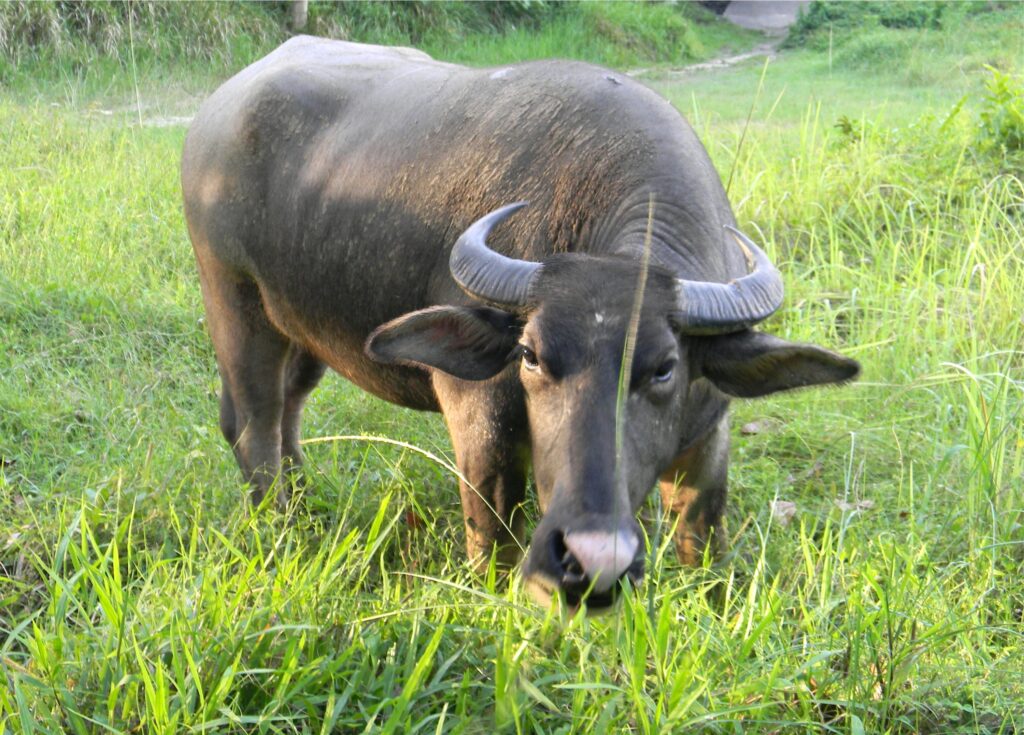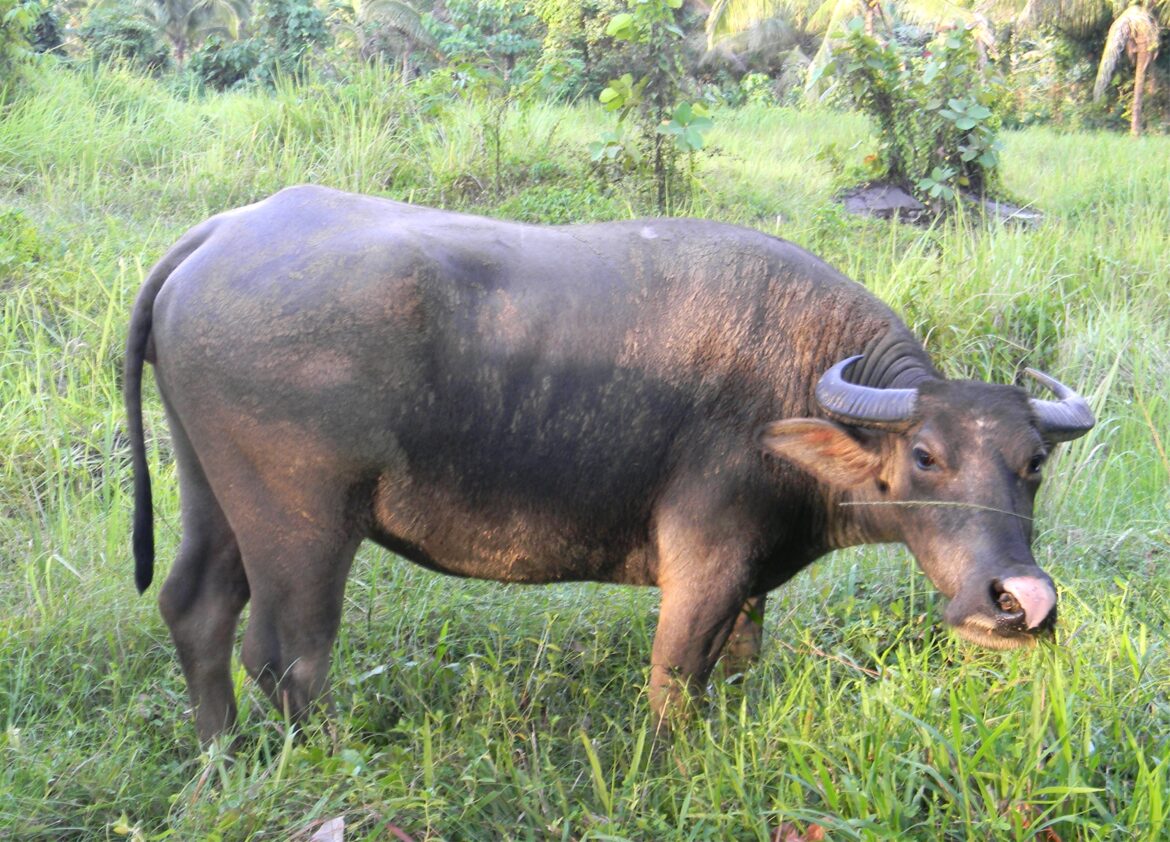Text and Photos by Henrylito D. Tacio
If you ask Filipinos living in rural areas to describe what a farmer looks like, don’t be surprised if carabao is also being mentioned. The two, after all, are partners when it comes to farming. The carabao is a Filipino farmer’s beast of burden.
“It does not seem that any mechanical device can easily replace this animal in preparing the soil for lowland rice, considering the diminutive farms scattered throughout the Philippines,” wrote Dr. Valente Villegas in his book, Carabao Husbandry.
Carabao is a versatile animal. “It is used in plowing fields for crops like sugar cane, corn, and upland rice, and even to better advantage than the ox when new land is to be opened and a stronger animal is needed,” Villegas noted.
In faraway places where trucks still cannot penetrate, carabao is used in transferring the sawed lumber from the mountains. That’s why there is such a thing as carabao logging. “For hauling logs from the forest and other heavy work,” Villegas pointed out, “(carabao) is unsurpassed in strength and stability.”
Despite the modernization of farming, most farmers in the hinterlands are still using carabao. Although there is still no law that decrees the carabao to be a national symbol in the country, it is generally considered by most Filipinos to be their national animal.
As of January 2021, the total carabao inventory in the country was estimated at 2.92 million heads, the Philippine Statistics Authority (PSA) reports. “The (figure) was 1.9% higher than the previous year’s same period head count of 2.87 million heads,” it said.
Most of these carabaos are raised by small-scale farmers. “Backyard farms, which contributed 99.7% to the country’s carabao population, recorded an improvement of 2.0%, from 2.86 million heads last year to 2.91 million heads this year.”
The bad news: carabao stocks in commercial farms decreased by -12.4%, from 10.63 thousand heads in 2020 to 9.31 thousand heads in 2021.
In terms of inventory, the PSA said the top three regions were Bicol, Western Visayas, and Central Luzon. “These regions accounted for 29.2% of the country’s total carabao population,” it said.
In the past, the number of carabao population declined as a result of low productivity, high extraction rate, and high mortality rate, according to the Laguna-based Philippine Council for Agriculture, Aquatic and Natural Resources Research and Development (PCARRD).
In the Philippines, the carabao is put to continuous work from the age of four years up to 15 years or beyond. Some studies have shown that three females can perform the work of two male carabaos. As a draft animal, the carabao is most remarkable. It pulls plows, harrows, and carts with loads of several tons, forging through mud up to its belly.
A research study done in 2002 showed that about 66% of the country’s total population at that time used carabao for farm work.

“The estimated value of the contributed draft power of the carabao is… US$1.48 million,” said Dr. Libertado C. Cruz, then the executive director of the Philippine Carabao Center (PCC), quoting the same study.
The PCC is an attached agency of the Department of Agriculture and is devoted to improving the country’s carabao. It was created by virtue of Republic Act 7307 in 1992 and became operational the following year.
The PCC’s mandate is: “to conserve, propagate, and promote the carabao as a source of milk, meat, draft power and hide to benefit the rural farmers.”
Carabao is not a native animal of the Philippines. Written history indicated that the country imported carabaos from China in the mid-1500s. There were two types of buffalos available, and the country selected the swamp type.
“It was the swamp type which was brought to the country,” the late agricultural journalist Anselmo S. Roque reported. “It is naturally excellent as a draft creature.” The other type, riverine buffalo, is considered best for meat and milk.
In the Philippines, the water buffalo earned the unique name “carabao.” Actually, the name came from the Cebuano word karabaw, which apparently was derived from “kerbau,” the Malaysian and Indonesian local name for the water buffalo.
There’s more to carabao than just a “beast of burden.” W. Ross Cockrill, the author of The Husbandry and Health of the Domestic Buffalo, said that in Brazil, buffaloes are credited for almost everything good.
For one, carabaos are also valued for its meat. “When carabaos are past their period of usefulness as draft animals, they are usually slaughtered and the meat is sold as carabeef,” wrote Ricardo R. Agana of S&T Media Service.
Based on data released by the United States Department of Agriculture, carabeef has 41% less cholesterol, 92% less fat, and 56% fewer calories than beef. Recent studies regarding the chemical composition of carabeef show that fresh carabeef obtained higher crude protein than pork and beef.
“Ground carabeef has an exquisite flavor and texture,” PCC said. “Buffalo meat is tender. It has little or no marbling or outside fat, so only a small amount of juice is lost when it is cooked.”
Carabeef is as good as beef when it is fed, managed, and slaughtered at the same age as cattle. PCAARRD’s Commodity Information Network for Ruminants said carabeef is an important component of comminuted products such as sausages, luncheon meat, meatloaf, and others. Canned corned beef is partly carabeef.
“The products that contain carabeef are attractive to consumers because they do not lose much of their original form when cooked,” Agana wrote. “Besides, it is cheaper than beef.”
In 2018, about 468,000 carabaos were slaughtered for meat production. “The total number of carabaos slaughtered for meat production in the country has fluctuated over the last ten years,” statista.com reported.
Carabao is also important because of its milk. “Carabao’s milk is considered as the finest milk among dairy animals and almost at par with human milk,” PCC said. “Like any other milk, it can be consumed anytime.”
In fact, carabao’s milk is considered the “most complete food” because it contains protein, fat, lactose, vitamins and minerals, and water. Carabao’s milk is richer and creamier than cow’s or goat’s milk due to its high percentage of milk fat, which is also a good source of energy.
The Philippines is only one percent sufficient in milk, some reports claim. This means 99% of dairy products being consumed in the country are imported. Cattle provides 64% of the total local milk volume while carabaos contribute only 34%.
Carabao is equally important for its hide. In the Philippines, people consume a lot of chicharon made of carabao hide, kare-kare, which is partly the skin of the animal, and a favorite pulutan, softened thin slices of hide spiced heavily with ginger, onion, and red pepper.
Carabao manure is also of economic importance. It’s an excellent organic fertilizer, containing 18.5 % nitrogen, 43.7 % phosphoric acid, and 9.6 % potash. It’s also a good source of fuel either as dried dung or in generating biogas or methane. When mixed with clay, the dung serves as building material or as plaster on the ground where palay is threshed.
Carabao production can very well be integrated with crop farming. However, its potential for draft animals, milk, and meat has not been fully exploited on account of several technical problems which limit its productive efficiency and utilization.
Among the identified constraints were poor reproductive capacity, low productivity, high mortality, and poor marketing. In 2009, the PCAARRD and its partners addressed these constraints.
In barangay Licaong, in the City of Muñoz, Nueva Ecija, PCAARRD’s science and technology interventions on dairy buffalo increased the milk production of farmers. Among the interventions employed were feeding calves with milk replacers and shortening the calving intervals through flushing of pregnant carabaos one month before and two months before calving.
Flushing involves giving the pregnant carabao a high nutrient density diet to boost its nutrition level in preparation for lactation. When the carabao is given good nutrition prior to and immediately after calving, it will come to heat sooner (after calving), can be bred earlier, and hence, deliver the next calf sooner. Thus, the interval between calves is shorter – from 18 months to 12.4 months.
Meanwhile, PCC is trying to increase the numbers of carabao in terms of quantity and to improve the herd’s genetic quality. One of the technologies that PCC employs for dairy herd buildup is artificial insemination (AI). This process of simulated reproduction involves extracting sperm from a quality male buffalo and injecting the sperm into the reproductive tract of a female buffalo.
PCC’s AI services are done nationwide by trained private village-based AI technicians as well as technicians of local government units, among others. AI is used to breed animals with higher productivity for both milk and meat by harnessing select animals’ excellent genetic materials.
“The carabao and Philippine agriculture will remain synonymous for many years to come,” PCC said. “This is because a large portion of our agriculture continues to be unirrigated. Moreover, land ownership of one hectare and below has significantly increased. This could be due to decreasing land area against the increasing number of farming families in the rural areas.
“Unless the industrial sector absorbs this available labor, they will remain dependent on the produce of their decreasing size of land. Hence, the integration of crops and livestock is the best way to survive. Carabao is therefore indispensable in this scenario,” PCC added.

